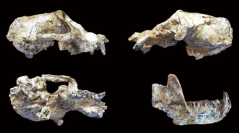

 Comptes Rendus Palevol
18 (8) - Pages 1057-1072
Comptes Rendus Palevol
18 (8) - Pages 1057-1072The fossil mammal localities of the Axios Valley (Macedonia, Greece) yielded a rich collection of Mesopithecus remains, which were first described at the beginning of the 1990s. The late Turolian Dytiko localities include several specimens of Mesopithecus, which were originally separated in two size-related forms: the relatively larger-sized M. cf. or aff. pentelicus, and the relatively smaller-sized M. cf. monspessulanus. However, some Dytiko specimens were only partially described, or remained even undescribed because the cranium either was still in connection with the mandible or was markedly deformed. Later, careful cleaning of the materials and their revision based on larger comparative samples indicate that they represent two distinct species: the relatively larger-sized specimens belong to M. pentelicus , while the relatively smaller-sized ones to M. monspessulanus. The Dytiko M. pentelicus has slightly smaller dental dimensions compared to M. pentelicus from Pikermi, indicating a possible trend for size decrease. The Dytiko M. monspessulanus, although close to the typical form of this species, has somewhat larger dimensions. The semi-terrestrial M. pentelicus disappeared at the end of the Miocene, while some of its populations adapted to the wetter and more woody Pliocene habitats, finally giving origin to M. monspessulanus, whose elbow-joint indicates an arboreal lifestyle. M. monspessulanus was widely distributed in Europe, but its remains are very scarce and are all from the Pliocene. Some questionable indications for the presence of M. monspessulanus in the latest Miocene come from some Italian Messinian sites (Gravitelli, Baccinello V3), but this scenario still needs verification. However, even if its presence in some Italian localities was confirmed, the Dytiko M. monspessulanus nonetheless represents the earliest known occurrence of this species in Europe, as the Dytiko fauna is considered as latest Turolian (pre-Messinian, 7.0–6.0 Ma).
Primates, Cercopithecidae, Mesopithecus, Late Turolian, Greece